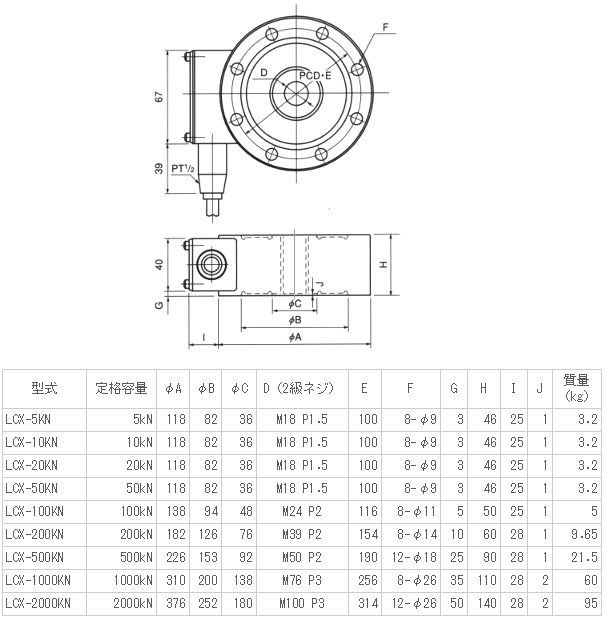【
Guangzhou Zhongxin Automation Technology Co., Ltd】Professional supply of NTS.LCX series from Japan
The weighing sensorThe LCX series
Japanese NTS weighing sensor)Ensure fast delivery time, 100% original and authentic products, and strive to become the first brand of sensor sales in China. Related models of Japanese NTS.LCX series weighing sensors: LCX-5KN, LCX-10KN, LCX-20KN, LCX-50KN, LCX-100KN, LCX-200KN, LCX-500KN, LCX-1000KN, LCX-2000KN.
Introduction to Japanese NTS LCX Series Products
Fixed capacity: 5kN to 2000kN
Fixed output: 2mV/V ± 0.25%
Non linearity: 0.05% R O.(500kN~1000kNは0.1%R. O. 2000kN is 0.3% R O.)
ヒステリシス:0.1%R. O.(500kN~1000kNは0.15%R. O. 2000kN is 0.3% R O.)
Return rate: 0.03% R O.
Pushing Inca voltage: 10V
Xurong Inca Voltage: 18V
Input and output resistance: 350 Ω± 1%
Absolute resistance: above 2000M Ω
Temperature compensation range: -10 to+70 ℃
Xu Rong temperature range: -20 to+80 ℃
The influence of temperature on zero point: ± 0.005% R O./℃
The impact of temperature on output: ± 0.005%/℃
Allowable overload: 150% R C.
ケープル: φ 10, 4-core ケープル 3m
Exterior dimensions of Japanese NTS LCX series
 Complete models of Japan NTS (NMB) LCX series
Complete models of Japan NTS (NMB) LCX series
| model |
Rated Capacity |
|
LCX-5KN |
5KN |
509.9kgf |
|
LCX-10KN |
10KN |
1.019tonf |
|
LCX-20KN |
20KN |
2.039tonf |
|
LCX-50KN |
50KN |
5.099tonf |
|
LCX-100KN |
100KN |
10.19tonf |
|
LCX-200KN |
200KN |
20.39tonf |
|
LCX-500KN |
500KN |
50.99tonf |
|
LCX-1000KN |
1000KN |
101.9tonf |
|
LCX-2000KN |
2000KN |
203.9tonf |
Expand Reading
Performance indicators of weighing sensorsThe performance of a weighing system can be measured by indicators such as linearity, hysteresis, repeatability, and creep.
Linear:Indicate the degree of consistency between the actual output of the system and the theoretical straight line. As shown in the figure, when a linear error occurs, the output of the system at no-load and full load is correct, but the input-output point between these two points is not consistent with the ideal state. Linear error is the maximum difference between the theoretical straight line and the actual output curve.
Lag:Indicates the degree to which the input-output curves of the system do not overlap during loading and unloading processes.
Repeatability:Indicates the degree of inconsistency in the weighing output of the same weight for several consecutive times during the loading or unloading process of the system. It is usually expressed as the percentage of the total output that is the difference between the minimum and maximum outputs of the system under the same loading conditions.
Creep:The characteristic that the system can withstand a constant weight at a certain temperature, and the output changes over time due to the mechanical deformation of the sensor's elastic material.
2、 Principles and differences of three - and four wire transmitters
Different wire systems refer to various outputs that simulate DC current signals
Weight transmitterThe difference in its working principle and structure does not only refer to the wiring form of the transmitter.
The term 'several wire system' only emerged after the birth of two-wire transmitters. This is the result of the widespread application of electronic amplifiers in instruments. The essence of amplification is an energy conversion process, which cannot be separated from power supply. Therefore, the first to appear were four wire transmitters; Two wires are responsible for supplying power, while the other two wires are responsible for outputting converted and amplified signals (such as voltage, current, etc.). The emergence of the DDZ-II electric unit combination instrument, with a power supply of 220v.ac and an output signal of 0-10mA The four wire DC transmitter has been widely used and can still be seen in some factories.
In the 1970s, China began producing DDZ-III electric unit combination instruments and adopted the International Electrotechnical Commission's (IEC) Analog Signal Standard for Process Control Systems. The instrument transmission signal adopts 4-20mA DC, The contact signal adopts 1-5V DC, The signal system adopts current transmission and voltage reception. Adopting 4-20mA DC signal, on-site instruments can achieve two-wire system. However, due to limitations, the two-wire system was only used on pressure and differential pressure transmitters at that time, while temperature transmitters still used the four wire system. Nowadays, the product range of two-wire transmitters in China has greatly expanded, and their application fields are also increasing. At the same time, transmitters imported from abroad are mostly two-wire.
The essence of the two-wire system is that the power supply and load are connected in series, with a common point. The signal connection and power supply between the on-site transmitter and the control room instrument only use two wires, which are both power and signal lines. The two-wire transmitter has a signal starting current of 4MA DC, Provided static operating current for the transmitter, while the electrical zero point of the instrument was 4MA DC, Not coinciding with the mechanical zero point, this "active zero point" is beneficial for identifying faults such as power outages and disconnections. Moreover, the two-wire system also facilitates the use of safety barriers, which is beneficial for safety and explosion prevention.
As shown in Figure 1, the two-wire power supply is 24V/DC, and the output signal is 4-20mA DC, The load resistance is 250 Ω, and the negative line potential of the 24V power supply is the lowest. It is the signal common line, and for smart transmitters, it can also be in the range of 4-20mA Load the FSK key control signal of the Hart protocol onto the DC signal.
The above is the detailed information of LCX-5KN~LCX-2000KN sensor-Japan NTS weighing sensor. If you have any questions about the price, delivery time, model, and inventory of LCX-5KN~LCX-2000KN sensor-Japan NTS weighing sensor, please call Mr. Chen at 18520271262 to obtain the latest price details of LCX-5KN~LCX-2000KN sensor-Japan NTS weighing sensor.

